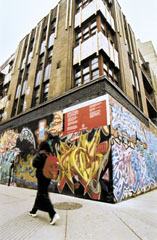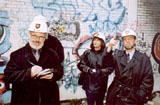
The exterior
of the York Theatre

Garry Milton
inside the York

Mike Boone and
others inspect the Theatre
|
Five architectural firms or
consortia of firms have been shortlisted for the design competition for
Concordia’s downtown buildings.
They will submit their entries, including artists’ conceptions, by
November 30, and make an oral presentation December 11. The decision will
be announced December 19, after which all five finalists’ submissions
will be displayed in the atrium of the J.W. McConnell Building and the
Vanier Library.
The architects have been told that while the design of the new buildings
should be aesthetically integrated, they will likely be constructed in
phases.
The university has been informed by the Ministry of Cultural Affairs that
the York Theatre is not a heritage property; thus Concordia is under no
legal obligation to preserve it. However, the university was asked to
be “good corporate citizens” in undertaking this construction
project.
The jury for the design competition comprises 10 voting members: Georges
Adamczyk, director of the school of architecture, Université de
Montréal: Mohsen Anvari, Dean of Commerce and Administration; Richard
de la Riva, architect, Affleck + de la Riva; Nabil Esmail, Dean of Engineering
and Computer Science; Kurt Forster, director of the Center for Canadian
Architecture; Christopher Jackson, Dean of Fine Arts; Martine Lehoux,
architect, and Director, Planning and Development; Rector Frederick Lowy;
Jonathan Wener, president of Canderel and chair of the Board’s real
estate planning committee; and another architect, as yet unnamed.
Legal Counsel Bram Freedman is the jury chair and legal advisor, and André
Leguerrier, of Planning and Development, is the project coordinator and
secretary.
The 45-day public consultation period has begun at both campuses.
Architectural design competition
finalists:
• Dan Hanganu / Faucher Aubertin Brodeur Gauthier / Leclerc &
associés
• Kuwabara Payne McKenna Blumberg architects / Fichten Soiferman
architectes
• Menkes Shooner Dagenais architectes / Dupuis Le Tourneux / N.O.M.A.D.E.
• Provencher Roy et associés
• Saucier + Perrotte / Nicolaidis Fukushima Orton Emmian architectes
Bring on the bulldozers,
says Mike Boone
Gazette city columnist
Mike Boone took a tour of the York Theatre last week, and pronounced it
raze-ready. He was countering a statement a few days earlier by city councillor
Helen Fotopoulos, who urged Concordia cinema students to rise up and protest
the university’s plans to level the long-empty former movie house.
The York has sat for many years, dark and forlorn, at the northwest corner
of Mackay and Ste. Catherine Sts. It is one end of an L-shaped site intended
for a new engineering and visual arts building for the university.
It was once a well-used venue, with a Art-Deco-inspired cinema theatre,
a spacious lobby and small apartments on the three floors above. In the
1980s, it saw stagings of the Rocky Horror Picture Show. Since
it was closed In 1989, however, the York has been a squat for street people,
and when Boone toured it with the university’s Garry Milton last
week, he could see that it is nothing more than a shell littered with
bricks, shards of glass and plaster dust.
Concordia acquired the building in 1998, and has spent $100,000 on safety
maintenance, including nailing two-by-fours on the exterior to keep the
bricks from falling on pedestrians. The university looked into restoration,
but was told that it would cost $9 million. The money isn’t available,
and this kind of space is not needed, as Concordia has several theatres
already.
In its heyday, the York lobby had four attractive frescoes (paintings
on plaster). They are in storage at Montreal’s Pointe à Callières
Museum, and the university hopes to display them in the new building as
a tribute to the York.
- Barbara Black
Arts and Science launches
internal appeal
The difference between this
and the other Faculty campaigns, Dean Martin Singer said, is that it is
for more than the new science building. The four categories of giving
are the building fund, the Undergraduate Scholars Fund, additional support
for graduate fellowships, and departmental needs.
Dean Singer has made a substantial personal donation, and hopes every
member of faculty will contribute. Moreover, he promised, “I will
never know the amount.”
Singer said that the Faculty is changing rapidly, a phenomenon he views
with enthusiasm, although he regrets so many valued colleagues leave on
retirement. Within two or three years, fully 40 per cent of the professors
in the Faculty will be newly hired.
There has been a 23-per-cent increase in international students in Arts
and Science, thanks to strong recruitment efforts, and now, a new bursary
program financed by Quebec will give our own students a chance to study
abroad.
Not only will the Faculty soon get a new science building, Singer said,
but he foresees “three or four” new buildings eventually. The
social sciences will be housed in a renovated Henry F. Hall Building,
and the humanities in the upper floors of the J.W. McConnell Building.
About 60 people attended the fundraising event in the Oscar Peterson Concert
Hall. As at previous fundraising launches in Engineering and Commerce,
there were short inspirational speeches by Rector Frederick Lowy, Vice-Rector/Secretary-General
Marcel Danis, and the chair of the Board of Governors’ advancement
committee, Richard Renaud.

This is a maquette of the
new science building planned for the Loyola Campus, designed by the architectural
consortium Marosi Troy/Jodoin Lamarre Pratte/Cardinal Hardy and Associates.
The 45-day consultation period required by the City of Montreal has begun.
The new science complex will comprise several departments, including Biology,
Chemistry and Biochemistry, Physics, Psychology, Exercise Science and
the Science College, as well as the Centre for Studies in Behavioural
Neurobiology and the Centre for Structural and Functional Genomics.
The Departments of Journalism and Communication Studies will relocate
to a refurbished Drummond Building, while the science departments’
move from downtown will free up more space on the Sir George Williams
Campus for the Faculty’s social science and humanities departments.
Dr. Lowy said that the university anticipates that construction of the
Science Complex will begin in the spring of 2001.
|
|
|



